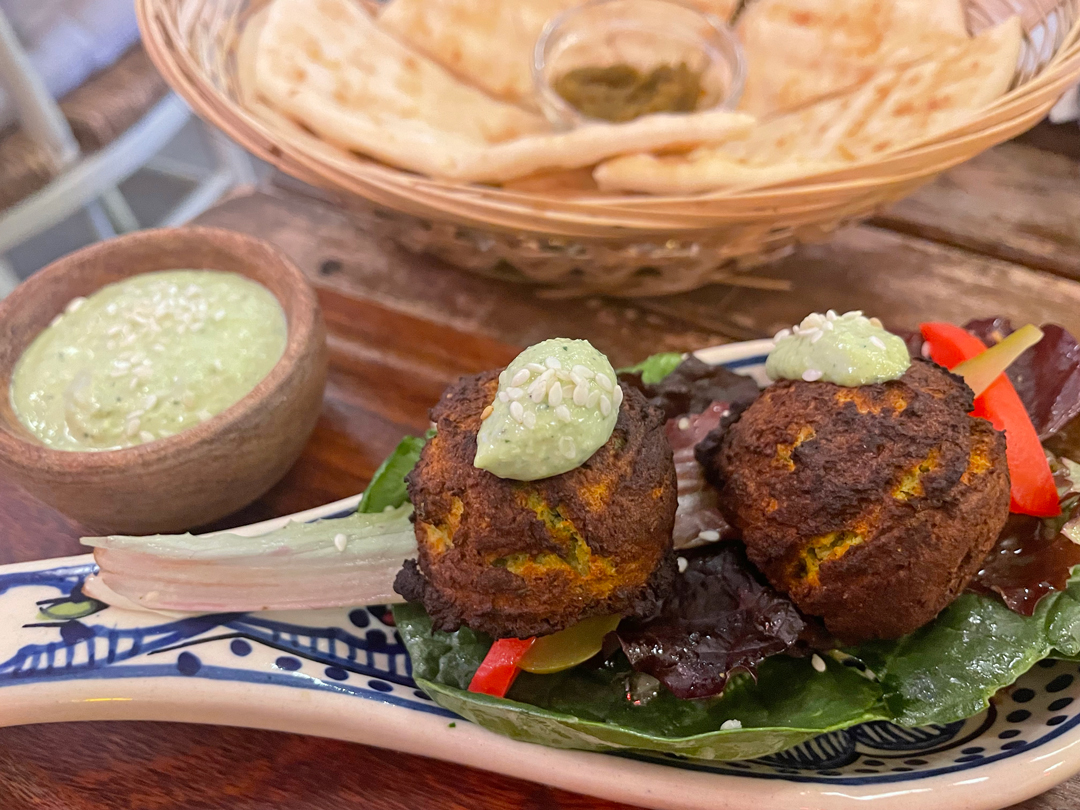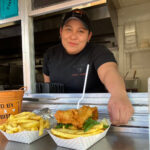
One August day in 2017, a young entrepreneur road-tripping from his home in New York City found himself in New Mexico. He and his then partner stopped to camp in Santa Fe, and the two made their way to the Plaza, where they found the streets overflowing with people wandering booths packed with Native-made art and crafts. “This is your lucky day,” the young man’s partner said to him, realizing their good fortune: they had landed in the city in the midst of Indian Market.
At the time, Malek Belghiti was the owner of a jewelry and handicrafts business specializing in Moroccan and Native American goods. Moroccan crafts were a natural for him, having grown up on the outskirts of Casablanca, and he had brought in Native artisans because their style seemed to mesh well with the aesthetics of his home country. “It was beautiful,” he told me, “to see the similarities between the work of Native and Moroccan artisans.”
On that trip, Belghiti fell in love with Santa Fe. With an MBA and many talents, he began plotting his escape from New York. When he returned to New Mexico, he took a restaurant job before landing a role with Bank of America working as a financial advisor. It was a good job, but, he said, “Something inside of me was missing. I was in service to people’s financial lives, but there was more to life.”

Belghiti was known among his New York friends for his generosity and skill in creating delicious Moroccan dishes. His cooking was inspired by the techniques of the women in his family, particularly an aunt who had lived in Fez, a city known for its distinctive cuisine, where Arabic, Berber, and Mediterranean traditions mingle. By enlisting her young nephew to cook with her, she taught him that patience, when it comes to food, pays off. A bustling souk near his home in Casablanca also allowed Belghiti to watch farmers sell their produce, teaching him to pay attention to quality ingredients and the care that goes into foods grown and harvested locally. “[My friends in New York] said I needed to open a restaurant,” he told me with no small amount of pride. Too, he was familiar with the world of food: as a student he had worked as a sous-chef and server in several New York restaurants, and he’d once owned an organic produce business in Morocco. So he began to think about leaving his bank job to explore a new venture, joining forces with his chef brother, Zack. The two cooked up a concept that would feature cuisine inspired by their native country made with organic and, whenever possible, local ingredients, focusing on vegetarian and vegan offerings.

Tajine had been around for several months before I finally stopped in one snowy night in January. I’m not sure what I expected, but I have to admit that even though I’d heard good things, I was skeptical. For one thing, I wasn’t sure about the location deep inside BODY’s retail space. Whatever my ideas as I passed the racks of high-end leggings and tables displaying luxury bed linens, my mind began to change when I arrived at the doors, inside of which once stood, if memory served, a row of fancy exercise equipment. The lights were dim, and the space was hushed. There was no wait for a table along the wall, and I considered the menu from a seat facing the open kitchen. There, a woman worked under warm light in meditative silence, folding thin pastry around what I would learn was the floral date-and-custard filling of a dessert called beau’azza,Tajine’s Moroccan spin on Greek bougatsa.
It had been a long day, and a cold one. I was tired, and tired of winter, and I kept my hat on even though it was plenty warm inside. The eggplant dish, za’alook, sounded good, and I chose one of the night’s special tajines listed on the tablet-sized chalkboard my server placed on the table. When the za’alook arrived and I tasted it, I was transported to, of all places, Providence, Rhode Island, where my brother lives. He had been to Morocco and enjoyed its food, and last summer he’d taken me to one of his favorite neighborhood spots, inviting me to try this most simple and spectacular dish. Tajine’s version was no less delicious.

Next came the tajine. It sizzled as my server opened it before me, and my first impulse was to crawl inside of the oven-hot ceramic dish where my meal had been slow-cooked. My server placed a tiny bowl of harissa beside it, and kindly explained to me how to use it. “This is harissa,” she advised, pointing to a brownish paste like a dollop of paint, explaining it was a kind of hot sauce. “Put a little on your fork,” she said, “and then take a bite of the dish.” I did as instructed, tasting the artful assemblage of slow-cooked vegetables, which included carrots and sweet potatoes, along with sumptuous slices of apricot and just a hint of peppery heat from the harissa. The dish’s aroma was equal to the flavor, like something a favorite aunt would make for the holidays, the kind of food there could never be enough of and that would live on in memory. I left that night feeling warm for the first time in what felt like weeks.
It’s no accident that one feels drawn to enter Tajine’s space and leaves feeling glowy. Locating at BODY came about through the brothers’ meeting with Lori Parrish, the studio’s spirited longtime owner and devotee of numerous wellness and healing arts modalities. When the brothers described their ideas to Parrish, there was some real vibing. A paradigm shift was afoot, the three agreed, with the convergence of climate change and health awareness and spiritual reawakening when it comes to food. “[Lori] had astonishing, beautiful ideas,” Belghiti recalls. She seemed to be expressing his own sensibilities about food; she understood his drive to always find the best ingredients and approach food with respect. He senses a change in his body when he eats a good, nutritious meal, he told me. “Food is energy. The ingredients, where they’re harvested and prepared, it’s all energy.”

I’ve returned to Tajine several times since then. I usually begin with a mezze platter, which features za’alook as well as several other favorites of mine including the divine lemon-accented bakoula and fresh Moroccan salad. I order at least one tajine, which I enjoy sharing with my husband or a friend. And mint tea, ubiquitous in Morocco, is a must to complete the sensory adventure, along with desserts like the vegan beau’azza and, for chocolate lovers, the chocolate tam’ra. I’ve been so pleased with the experience that I was surprised when Belghiti told me his restaurant is only in a soft opening phase. The grand opening, set to include additional seating, will come this summer.

In keeping with his brand of grounded optimism, Belghiti didn’t seem in any rush for the full launch. Right now is a time of experimentation, he said, seeming glad for the space to roam before locking down the details. He emphasized that though vegans and vegetarians will be pleased with the offerings, the place is for everyone (a reluctant carnivore, I found that to be more than true). As our conversation wound down, I realized what a gift it can be to experience a truly special restaurant in its nascent phase, and for a moment I hesitated before asking Belghiti about his intentions for the future, because I wasn’t sure how I’d handle any hints of uncertainty. (Think of the friends this man left in New York, deprived of their homemade Moroccan dinners!) “Do you think you’ll stay in Santa Fe?” I asked. “Oh yes,” he said, as if it were a given, and though we were on the phone I thought I could hear him smiling. “I really love this town.” When I replied with relief, he seemed pleased. “Yes,” he repeated, “this is absolutely home.”
*Besseha is a Moroccan Arabic expression that means “cheers” or “bon appétit.”

Susanna Space
Susanna Space’s essays have appeared at Guernica, The Rumpus, The Los Angeles Review, and many other literary outlets. She is a former associate editor with edible New Mexico and The Bite.







